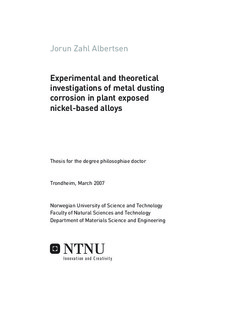| dc.description.abstract | This doctoral thesis is concerned with experimental and theoretical studies of high temperature corrosion phenomena in plant exposed nickel-based alloys. Different complementary experimental techniques have been used to unravel the microstructural changes and phase formations accompanying the corrosion process, including light microscopy, hardness measurements, field emission scanning electron microscopy (FEG SEM), microprobe / WDS analyses, transmission electron microscopy (TEM) and synchrotron X-ray diffraction (S-XRD). These results together with thermodynamic and kinetic modelling of the rate phenomena involved have provided new insight into the mechanisms of metal dusting corrosion in Ni-based alloys under real plant exposure conditions that have not previously been disclosed using accelerated laboratory tests.
The thesis is divided into five parts.
Part Ι gives a general introduction to metal dusting corrosion. In particular, aspects of metal dusting corrosion in low alloyed steels, complex engineering alloys and nickel-based alloys have been reviewed and put into proper perspective.
In Part ΙΙ of the thesis a research strategy aiming at a more fundamental understanding of the mechanisms of metal dusting corrosion is presented. Then a full description of the materials, exposure conditions and the experimental techniques being applied throughout the investigations is given as a lead-in to the subsequent microstructure and phase characterisation.
In Part ΙΙΙ of the thesis, metallurgical characterisation of the nickel based alloy 602 has been carried out following plant exposure at approximately 540°C for 2 years. In general, alloy 602 is found to exhibit a high intrinsic resistance to metal dusting corrosion under the prevailing circumstances. Only a thin zone is affected by carbon intrusion, extending about 20μm from the surface and into the bulk of the material. The subsequent FEG SEM and S-XRD analyses of the exposed 602 alloy revealed the presence of various phases at the corroded surface, including nepheline (NaAlSiO4) and presumably also corundum (Al2-xCrxO3). None of these oxide phases are commonly observed in connection with metal dusting corrosion.
In Part ΙV of the thesis, the surface disintegration and microstructural stability of the two nickel-based alloys 602 and 693, containing varying levels of chromium and aluminium, have been examined both during oxidising conditions in the laboratory and following 2 and 4 years of exposure to syngas in an industrial plant for methanol production at 540°C and 35 bar total pressure. The near surface phases were investigated using optical microscopy and hardness measurements, and further characterised by employing synchrotron X-ray diffraction (XRD) in combination with scanning and transmission electron microscopy (SEM/TEM). The disintegration process starts by rejection of α-Cr from the supersaturated austenite matrix. The process proceeds by reactions between the surface oxide layer and the syngas containing the trace elements Si, Na, Ni at the ppb level. The former elements contribute to the development of nepheline (NaAlSiO4) at the outmost surface facing the gas, whereas the deposited Ni particles from the syngas promote coke formation by catalysing the Boudouard reaction (2CO = C + CO2). On the inside a mixed Cr2O3-Al2O3 oxide layer is observed, both in the steam oxidised and plant exposed alloys. In particular, the inner aluminium oxide is very dense and provides an effective getter against carbon intrusion into the bulk of the alloys by virtue of its ability to restore cracks and flaws through diffusion. Eventually, restrictions in the supply of reactants (e.g. Al) to the oxide/ metal interface complete the incubation period and lead to the formation of corrosion pits at the bottom of the open surface cracks being in direct contact with the syngas atmosphere.
Finally, Part V is concerned with fundamental studies of the mechanisms of metal dusting corrosion in the Ni-based alloys 602 and 693 during long time exposure to syngas at 540oC and 35 bar total pressure. Four years plant exposed alloys were examined using synchrotron X-ray diffraction in combination with scanning- and transmission electron microscopy. It is concluded that the metal dusting corrosion attacks start by carbon diffusing into the bulk of the alloys following the break-down of the protective Cr2O3 - Al2O3 surface oxide layer. During the incubation period this oxide layer provides an effective barrier against carbon intrusion by virtue of its ability to restore cracks and flaws through diffusion. The corrosion pits then grow by a process of internal carburisation and oxidation, where carbides, oxides and graphite form separately within an approximately 30μm thick belt in front of the pits (referred as the white zone). In particular, the oxidation of the internal Cr3C2 carbides occurring close to the white zone/pit interface is associated with large volume changes. This volume expansion results in build-up of high mechanical stresses within the white zone and eventually to the complete disintegration of the original alloy matrices into a layered pit microstructure consisting of Ni + Fe and Cr2O3 + Al2O3 + graphite, respectively. The observed microstructural changes have been rationalised through detailed modelling of the physical reactions involved, leading to the development of new and comprehensive models for metal dusting corrosion in Ni-based alloys. | nb_NO |
